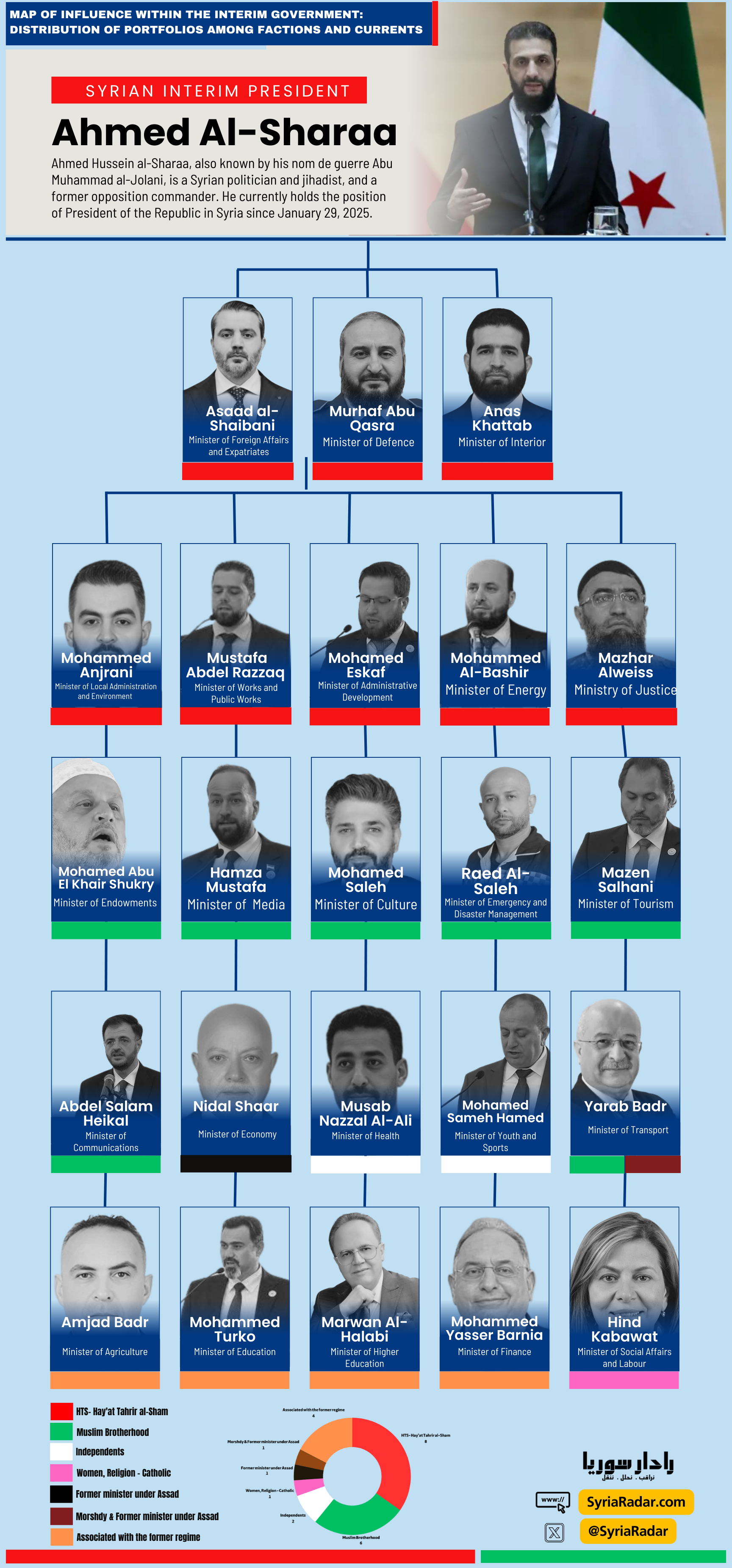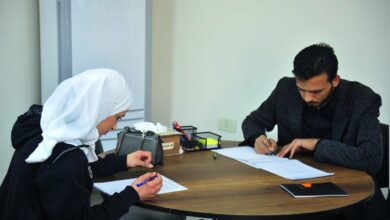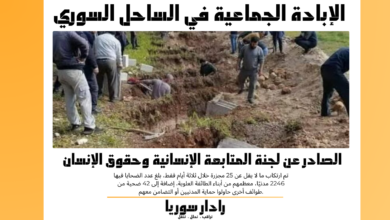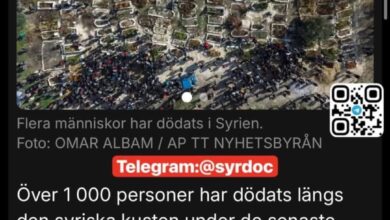🗺️ خريطة النفوذ داخل الحكومة المؤقتة في سوريا, توزيع الحقائب الوزارية بين الفصائل والتيارات
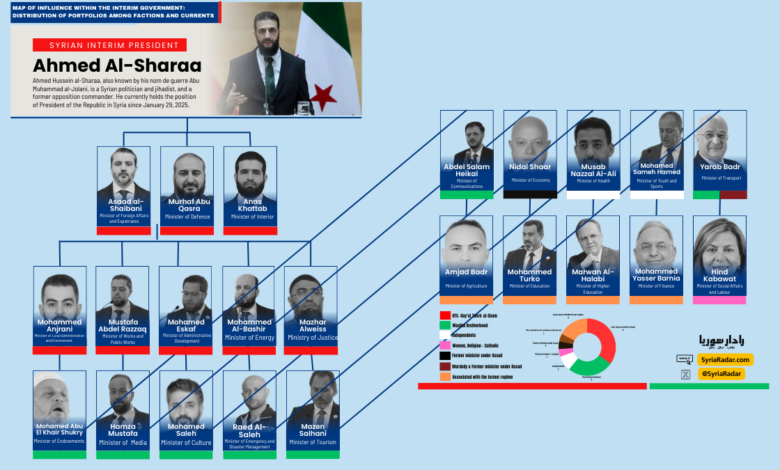
إعداد: فريق التحليل السياسي في رادار سوريا
بإشراف شيروان شاهين – محرر منصة رادار سوريا
This report is available in Arabic and English | هذا التقرير متوفر باللغتين العربية والإنجليزية
في 29 يناير 2025، تولّى أحمد الشرع، المعروف باسمه الحركي أبو محمد الجولاني، منصب رئاسة الجمهورية في سوريا ضمن إطار حكومة مؤقتة جديدة. ورغم أن هذا التعيين شكّل نقطة تحوّل مفصلية في المسار السياسي للبلاد، إلا أن القراءة الحقيقية لمراكز القوة داخل الحكومة الجديدة لا تكمن في الأسماء أو العناوين، بل في الألوان والانتماءات والولاءات.
توزيع الحقائب في الحكومة المؤقتة في سوريا لا يعكس توافقًا سياسيًا شاملاً، بل يُجسّد خريطة النفوذ الواقعي بين الفصائل المسلحة والتيارات الأيديولوجية المهيمنة على الأرض. في هذا التقرير التحليلي، تقدّم منصة رادار سوريا قراءة معمّقة في تركيبة الحكومة المؤقتة الجديدة برئاسة أحمد الشرع، كاشفةً عن التوزيع الحقيقي للسلطة بين هيئة تحرير الشام، الإخوان المسلمين، وعدد من الشخصيات المرتبطة بالنظام السابق.
تُبرز هذه الإنفوغرافيك الهيكل الفعلي للحكومة، وتُظهرها كائتلاف تفاهمي بين قوى الأمر الواقع، لا كحكومة تكنوقراط ولا كتمثيل وطني جامع.
🔴 هيئة تحرير الشام – من القوة العسكرية إلى السلطة السياسية
أبرز ما يلفت النظر هو الحضور الطاغي لـ هيئة تحرير الشام (HTS)، والتي يُمثَّل وزراؤها باللون الأحمر. الهيمنة شملت الوزارات السيادية الثلاث: الدفاع، الداخلية، والخارجية. وهذه الحقائب تشكّل العمود الفقري لأي دولة، مما يجعل الهيئة اللاعب المركزي في الحكومة. النفوذ الميداني انتقل رسميًا إلى نفوذ حكومي.
🟢 الإخوان المسلمون – نفوذ ناعم بمضامين استراتيجية
يُظهر اللون الأخضر الوزارات التابعة لـ الإخوان المسلمين، والتي شملت الإعلام والثقافة والسياحة. هذه الوزارات ليست هامشية كما يُعتقد، بل تُستخدم لصياغة الرواية الرسمية وتشكيل الوعي العام، وهي أدوات مؤثرة لبناء الدولة الأيديولوجية التي يسعى الإخوان لترسيخها.
⚪ المستقلون والتكنوقراط – حضور شكلي دون تأثير حقيقي
بعض الوزارات، مثل الصحة والشباب، تولاها وزراء مستقلون يُشار إليهم باللون الأبيض. وجودهم يُفهم كخطوة رمزية لإظهار الانفتاح والتنوع، لكنه لا يعكس ثقلًا حقيقيًا في رسم السياسات.
🌸 تمثيل رمزي للمرأة والأقليات الدينية
تظهر وزارة الشؤون الاجتماعية والعمل بقيادة شخصية نسائية كاثوليكية, ممثَّلة باللون الزهري. هذه الخطوة، وإن كانت رمزية، تسجل أول تمثيل واضح للمرأة والدين المسيحي في حكومة يغلب عليها الطابع الذكوري والإسلامي، لكنها تبقى استثناء لا قاعدة.
⚫🟤🟠 عودة رموز النظام السابق
من اللافت عودة شخصيات محسوبة على نظام الأسد:
- ⚫ وزير سابق في عهد الأسد يتولى وزارة الاقتصاد.
- 🟤 مرشدي – ووزير سابق في عهد الأسد يتسلم وزارة النقل.
- 🟠 شخصيات محسوبة على النظام تتقلد وزارات حساسة مثل المالية.
هذه العودة تطرح تساؤلات حادة حول حدود القطيعة مع النظام، واحتمال أن تكون هذه الحكومة مجرد إعادة تدوير لوجوه مألوفة ضمن إطار جديد.
⚖️ حكومة وحدة وطنية؟ أم تحالف نفوذ؟
يبقى السؤال الأساسي: هل هذه التشكيلة تمثّل فعلاً حكومة وحدة وطنية؟ أم أنها مجرد تحالف قوى أمر واقع أُلبس ثوب الرسمية؟
الواقع يعكس مشهداً أكثر تعقيدًا. فالتحالف الظاهري بين قوى متباينة أيديولوجيًا وسياسيًا قد لا يصمد أمام تحديات الحكم، وهو عرضة للشلل الداخلي والانقسامات. الحكم الفعلي سيكون مرهونًا بمدى قدرة هذه المكونات على التعاون، أو صراعها على النفوذ داخل الدولة الوليدة.

Map of Influence within Syria’s Interim Government
Distribution of Portfolios among Factions and Currents
By the Syria Radar Political Analysis Desk
Supervised by Sherwan Shahin – Editor, Syria Radar Platform
On January 29, 2025, Ahmed Al-Sharaa, known widely by his nom de guerre Abu Muhammad Al-Jolani was sworn in as president of Syria’s new interim government. The move, while symbolically significant, raised immediate questions about who truly governs from behind the scenes
A closer examination of the cabinet reveals a government not born of consensus, but carved through power-sharing among armed factions and ideological actors. What presents itself as a technocratic body is, in reality, a fragile architecture of influence, one that grants critical ministries to Hay’at Tahrir al-Sham, the Muslim Brotherhood, and even remnants of the former regime
Syria’s so-called “new era” may come wrapped in different language, but beneath the surface, the state remains a patchwork of competing power centers, not a unified national project
🔴
HTS – From Militant Power to Political Authority
The most dominant force within the government is Hay’at Tahrir al-Sham (HTS). The former militant group now holds the core portfolios of Defense, Interior, and Foreign Affairs, effectively placing the tools of sovereignty into the hands of a faction that once operated from Syria’s shadows. What HTS lacked in formal legitimacy, it has now gained through cabinet control. This shift signals something more profound than a change in uniforms: it’s a military-to-political transition playing out in real time, and largely on HTS’s terms
🟢
The Muslim Brotherhood’s Strategic Soft Power
While HTS secures the hard power, the Muslim Brotherhood has staked its influence in the narrative space: the Ministries of Media, Culture, and Tourism. These seemingly soft domains serve as crucial platforms for ideological messaging, national identity construction, and long-term public shaping. This isn’t about infrastructure. It’s about hearts and minds
⚪
Technocrats & Independents: Present, but Peripheral
The government includes a handful of independents and technocrats, mostly assigned to Health, Youth, and minor social portfolios. Their presence offers a veneer of professionalism, but little in the way of policy influence. These are names meant to impress donors, not direct strategy
🌸
Inclusion of Religious and Gender-Based Representation
One portfolio, Social Affairs and Labor, is held by a Christian woman, a rare moment of inclusion in Syria’s overwhelmingly male and Sunni power landscape. But in a 25-member cabinet, symbolism doesn’t equal structure
⚫🟤🟠
Legacy of the Assad Regime Lives On
Perhaps most jarring is the return of figures tied to the former Assad regime. Some are overt, ex-ministers now heading Economy and Transport. Others are more subtle: advisors, technocrats, and loyalists rebranded for a new phase. Their inclusion suggests either a quiet pragmatism, or a calculated compromise to ease internal tensions or foreign relations
⚖️
?A Cabinet of Convenience or a Coalition of Control
At first glance, this government may resemble a coalition of necessity. But a deeper reading points to institutionalized factionalism. It is not a unity government. It is a power map — where color codes, not qualifications, determine office. Whether this structure can govern coherently, respond to humanitarian crises, or gain international legitimacy is another question entirely. For now, one thing is clear: in Syria’s interim cabinet, what you see depends entirely on what you know
